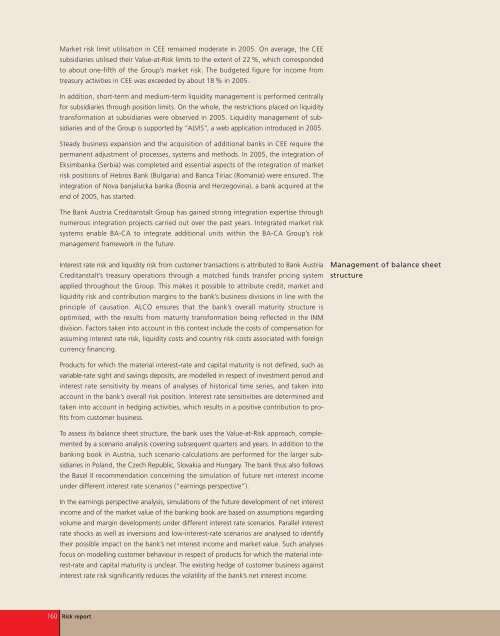team spirit - Bankier.pl
team spirit - Bankier.pl
team spirit - Bankier.pl
You also want an ePaper? Increase the reach of your titles
YUMPU automatically turns print PDFs into web optimized ePapers that Google loves.
Market risk limit utilisation in CEE remained moderate in 2005. On average, the CEE<br />
subsidiaries utilised their Value-at-Risk limits to the extent of 22 %, which corresponded<br />
to about one-fifth of the Group’s market risk. The budgeted figure for income from<br />
treasury activities in CEE was exceeded by about 18 % in 2005.<br />
In addition, short-term and medium-term liquidity management is performed centrally<br />
for subsidiaries through position limits. On the whole, the restrictions <strong>pl</strong>aced on liquidity<br />
transformation at subsidiaries were observed in 2005. Liquidity management of subsidiaries<br />
and of the Group is supported by “ALVIS”, a web ap<strong>pl</strong>ication introduced in 2005.<br />
Steady business expansion and the acquisition of additional banks in CEE require the<br />
permanent adjustment of processes, systems and methods. In 2005, the integration of<br />
Eksimbanka (Serbia) was com<strong>pl</strong>eted and essential aspects of the integration of market<br />
risk positions of Hebros Bank (Bulgaria) and Banca Tiriac (Romania) were ensured. The<br />
integration of Nova banjalucka banka (Bosnia and Herzegovina), a bank acquired at the<br />
end of 2005, has started.<br />
The Bank Austria Creditanstalt Group has gained strong integration expertise through<br />
numerous integration projects carried out over the past years. Integrated market risk<br />
systems enable BA-CA to integrate additional units within the BA-CA Group’s risk<br />
management framework in the future.<br />
Interest rate risk and liquidity risk from customer transactions is attributed to Bank Austria<br />
Creditanstalt’s treasury operations through a matched funds transfer pricing system<br />
ap<strong>pl</strong>ied throughout the Group. This makes it possible to attribute credit, market and<br />
liquidity risk and contribution margins to the bank’s business divisions in line with the<br />
princi<strong>pl</strong>e of causation. ALCO ensures that the bank’s overall maturity structure is<br />
optimised, with the results from maturity transformation being reflected in the INM<br />
division. Factors taken into account in this context include the costs of compensation for<br />
assuming interest rate risk, liquidity costs and country risk costs associated with foreign<br />
currency financing.<br />
Products for which the material interest-rate and capital maturity is not defined, such as<br />
variable-rate sight and savings deposits, are modelled in respect of investment period and<br />
interest rate sensitivity by means of analyses of historical time series, and taken into<br />
account in the bank’s overall risk position. Interest rate sensitivities are determined and<br />
taken into account in hedging activities, which results in a positive contribution to profits<br />
from customer business.<br />
To assess its balance sheet structure, the bank uses the Value-at-Risk approach, com<strong>pl</strong>emented<br />
by a scenario analysis covering subsequent quarters and years. In addition to the<br />
banking book in Austria, such scenario calculations are performed for the larger subsidiaries<br />
in Poland, the Czech Republic, Slovakia and Hungary. The bank thus also follows<br />
the Basel II recommendation concerning the simulation of future net interest income<br />
under different interest rate scenarios (“earnings perspective”).<br />
In the earnings perspective analysis, simulations of the future development of net interest<br />
income and of the market value of the banking book are based on assumptions regarding<br />
volume and margin developments under different interest rate scenarios. Parallel interest<br />
rate shocks as well as inversions and low-interest-rate scenarios are analysed to identify<br />
their possible impact on the bank’s net interest income and market value. Such analyses<br />
focus on modelling customer behaviour in respect of products for which the material interest-rate<br />
and capital maturity is unclear. The existing hedge of customer business against<br />
interest rate risk significantly reduces the volatility of the bank’s net interest income.<br />
160 Risk report<br />
Management of balance sheet<br />
structure
















